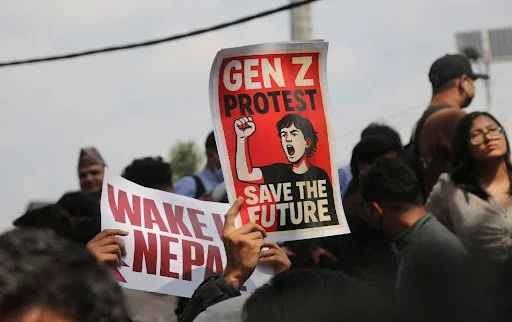Social Media: A Start, a Means, and an End to Revolution in Nepal
Young Nepali demonstrators organize under their “Gen Z” title on September 8, 2025. Source: Sunil Pradhan/Anadolu.
Discord, a communication platform primarily used by gamers, is many things: a spot to share content, send texts, form online communities, join video calls, and more. Recently, however, as thousands of Generation Z Nepalese looked to it in the face of political estrangement, Discord became something special: a platform for radical change and a “pseudo-parliament” to hold an election among over 100,000 users. The 2025 Nepalese uprising saw not only the transformation of Nepal’s government but also the transformation of the idea of revolution.
It was social media that first sparked the protests, though the reasons for unrest expanded much further. After the Nepali government banned twenty-six social media platforms, including Facebook, YouTube, and X, for failing to meet a slew of complex regulations, many grew emphatic. Considering nearly half of Nepal’s population uses social media, the government’s move was regarded as an explicit suppression of speech.
Combined with the underlying grievances of governmental corruption, elitist privilege, and financial inequality, this ban resulted in nationwide unrest. Tapping into this uproar, Sudan Gurung, the leader of Hami Nepal, a non-profit earthquake relief organization-turned-mobilizer-and-negotiator, utilized VPNs to bypass the social media ban — as did many other demonstrators — and urged Nepali citizens on Instagram and Discord to participate in demonstrations.
And that they did. On September 8th, cities across the nation were overrun by protestors organizing under the name “Gen Z.” The gatherings in Nepal’s capital, Kathmandu, were especially significant. Thousands attended Hami Nepal’s peaceful rally from Maitighar Mandala, a symbolic monument in the heart of the capital, to the Parliament building. Sources are generally conflicted over the exact order of events, but it is understood that police began firing live ammunition into the crowd in Kathmandu after tear gas and rubber bullets failed to disperse it.
Following the nineteen deaths that resulted from this police brutality, passion turned to rage. The government was rattled enough after protests intensified to lift the social media ban later that same night.
But the protests were never about social media. Social media was simply the spark that ignited the powder keg. The protests only grew, pressuring Prime Minister K.P. Sharma Oli to eventually resign on September 9.
As the government toppled, demonstrators pushed harder, setting fire to government buildings and private residences. The death toll steadily increased, and the country was in turmoil, with over 15,000 prisoners breaking out of jail. In light of this death and destruction, protestors saw an opportunity, one that would dramatically shift understandings of modern uprisings and political ideals.
Over 100,000 citizens turned to Discord once again; this time with reconstruction on their minds. In a remarkable display of Gen Z political resolve, users simulated a “mini-election” and, within 24 hours, settled on a new interim leader, Sushila Karki, Nepal’s first female prime minister. The protests had soon died down and ended on September 13, with a final death toll of seventy-two.
Social media has, in recent times, been a catalyst for protest. It can quickly raise awareness among multitudes of users and bring like-minded people together. Using it to decide the political future of a country, however, is unprecedented. The Nepalese Gen Z protests were sparked by a social media ban, carried out with the help of social media, and ended with an election held on social media. Whether the ideals of this digitally conceived government will remain reflected in Nepal’s political future remains unknown. Using social media to form a new government is not something seen every day, and its implications are uncertain.
One thing is clear: social media is no longer simply a way to spread awareness. It is a free, unrestricted platform capable of fostering profound change. There are no political parties and institutions to run the show, just thousands of users demanding change, and doing so in a decentralized, accessible, and familiar way. Nepali Gen Zers briefly established a political system free of suppression or domination. Though the long-term effects of this are unknown, the future may hold a greater role for social media in politics. Revolutions are no longer restricted to the streets.

